|
|
|
||

| |||
| Kepler Astrophysics News | |||
| +kepler blog +mission status +KASC news |
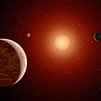
|
|
EARTH-BASED OBSERVATIONS LEAD TO KEPLER PLANET CANDIDATES IN HABITABLE ZONES
Work by Phil Muirhead et al. has been published in the Astrophysical Journal. The paper reports revised temperatures, masses, metallicities, and radii for 84 Kepler planet-candidate host stars, most of which are red dwarf stars. The new stellar radii are significantly less than the values previously reported. Applying the published Kepler transit parameters, the paper's authors report new physical radii for the planet candidates, new equilibrium temperatures of the planet-candidates, and that 3 of the planet-candidates are terrestrial-sized with orbital semi-major axes that lie within the habitable zones of their host stars (KOI 463.01, KOI 812.03 and KOI 854.01). +read more |
|
ALMOST ALL OF KEPLER'S MULTIPLE-PLANET CANDIDATES ARE PLANETS
Jack Lissauer and collaborators present a statistical analysis that demonstrates that the overwhelming majority of Kepler candidate multiple transiting systems indeed represent true, physically associated transiting planets. Binary stars provide the primary source of false positives among Kepler planet candidates, implying that false positives should be nearly randomly distributed among Kepler targets. There are more than one hundred times as many Kepler planet candidates in multi-candidate systems as would be predicted from a random distribution of candidates, implying that the vast majority are true planets. +read more |
|
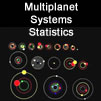
|
|
NASA APPROVES KEPLER MISSION EXTENSION
NASA's Kepler mission has been approved for extension through fiscal year 2016 based on a recommendation from the Agency’s Senior Review of its operating missions. Excerpt from the 2012 Senior Review report: "Kepler offers a new technical capability, opening a new measurement parameter space, and as often happens with such developments, that has led to unexpected results…. There has been a continuous stream of new findings - the assimilation and exploitation of new opportunities is just beginning...". +read more |
||
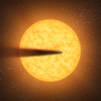
|
|
POSSIBLE DISINTEGRATING SHORT-PERIOD SUPER-MERCURY
Saul Rappaport and calloborators report on the discovery of stellar occultations, observed with Kepler, that recur periodically at 15.685 hour intervals, but which vary in depth from a maximum of 1.3% to a minimum that can be less than 0.2%. They cannot be due solely to transits of a single planet with a fixed size. Rappaport et al. come down in favor of an explanation that involves macroscopic particles escaping the atmosphere of a slowly disintegrating planet not much larger than Mercury. The occultation profile could reflect a comet-like dust tail trailing the planet. +read more |
|
PLANETARY CANDIDATES DETECTED BY KEPLER DURING THE FIRST 16 MONTHS OF DATA COLLECTION
1,091 new transiting planet candidates have emerged from analysis of Kepler spacecraft data spanning May 2009 to September 2010, bringing the total count to 2,321 Kepler planet candidates orbiting 1,790 host stars. The fraction of host stars with multiple candidates has grown from 17% to 20%. The cumulative catalog now contains over 200 Earth-size planet candidates and more than 900 super-Earths. Of the 46 planet candidates found in the habitable zone, 10 are near-Earth-size. A clear trend toward smaller planets at longer orbital periods is evident with each new catalog release. This suggests that Earth-size planets in the habitable zone are forthcoming if, indeed, such planets are abundant. Data and sample analyses are presented in Batalha et al. (2012). An updated table of planet candidates is archived within the Kepler data archive at MAST, and a sortable, filterable table with orbital ephemeris and light curve folding tools at NExScI's Exoplanet Archive. |
|
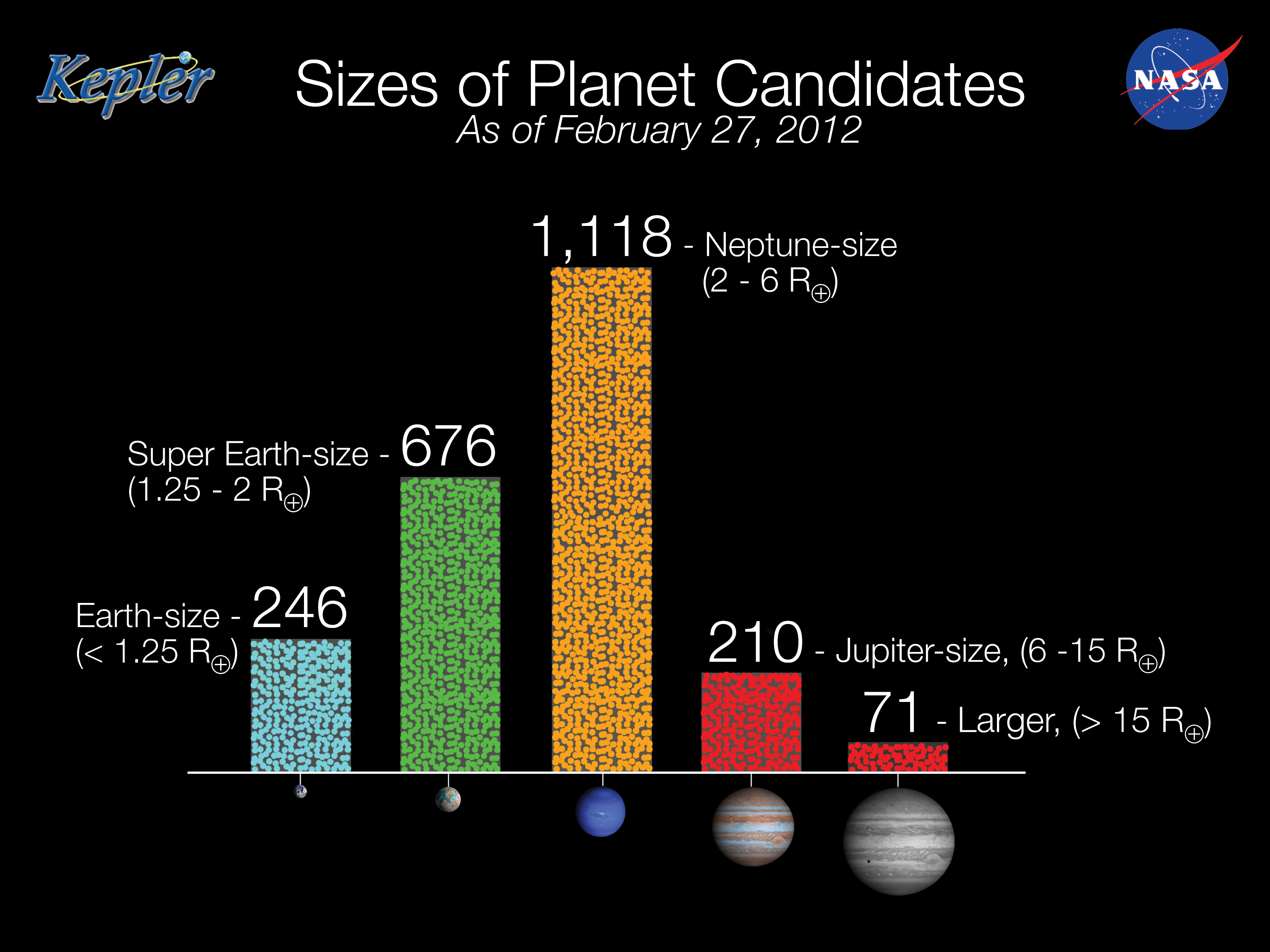
|
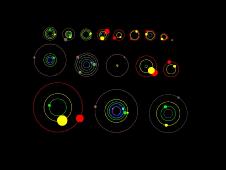
|
|
KEPLER ANNOUNCES 11 PLANETARY SYSTEMS HOSTING 26 PLANETS
NASA's Kepler mission has discovered 11 new planetary systems hosting 26 confirmed planets. These discoveries nearly double the number of verified planets and triple the number of stars known to have more than one planet that transits, or passes in front of, the star. Such systems will help astronomers better understand how planets form. The planets orbit close to their host stars and range in size from 1.5 times the radius of Earth to larger than Jupiter. Fifteen are between Earth and Neptune in size. Further observations will be required to determine which are rocky like Earth and which have thick gaseous atmospheres like Neptune. The planets orbit their host star once every six to 143 days. All are closer to their host star than Venus is to our sun. +read more |
|
KEPLER MISSION FINDS THREE SMALLEST EXOPLANETS
Astronomers using data from NASA's Kepler mission have discovered the three smallest planets yet detected orbiting a star beyond our sun. The planets orbit a single star, called KOI-961, and are 0.78, 0.73 and 0.57 times the radius of Earth. The smallest is about the size of Mars. All three planets are thought to be rocky like Earth, but orbit close to their star. That makes them too hot to be in the habitable zone, which is the region where liquid water could exist. Of the more than 700 planets confirmed to orbit other stars -- called exoplanets -- only a handful are known to be rocky. +read more |
|
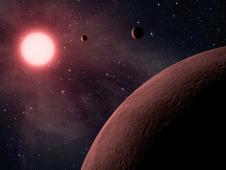
|
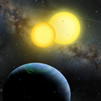
|
|
KEPLER DISCOVERY OF TWO MORE CIRCUMBINARY PLANETS ESTABLISHES NEW CLASS
Kepler astronomers announced the discovery of two new transiting “circumbinary” planet systems – planets that orbit two stars. This work establishes that such “two sun” planets are not rare exceptions, but are in fact common with many millions existing in our Galaxy. While long anticipated in both science and science fiction, the existence of a circumbinary planet orbiting a pair of normal stars was not definitively established until the discovery of Kepler-16 b, announced by the Kepler Team last September. Like Kepler-16 b, these new planets also transit (eclipse) their host stars, making their existence unambiguous. When only Kepler-16 b was known, many questions remained about the nature of circumbinary planets – what kinds of orbits, masses, radii, temperatures, etc., could they have? And most of all, was Kepler-16 b just a fluke? With the discovery of Kepler-34 b and 35 b, astronomers can now answer many of those questions and begin to study an entirely new class of planets. +read more |
|
A COMPACT SYSTEM OF SMALL PLANETS AROUND A FORMER RED-GIANT STAR
Planets that orbit their parent star at less than about 1 AU are expected to be engulfed when the star becomes a red giant. Stephane Charpinet and collaborators report in Nature the presence of two nearly Earth-sized bodies orbiting the post-red-giant, hot B subdwarf star KIC 05807616 at distances of 0.0060 and 0.0076 AU, with orbital periods of 5.7625 and 8.2293 hours, respectively. These bodies probably survived deep immersion in the former red-giant envelope. They may be the dense cores of evaporated giant planets that were transported closer to the star during the engulfment and triggered the mass loss necessary for the formation of the hot B subdwarf, which might also explain how some stars of this type did not form in binary systems. +read more |
|
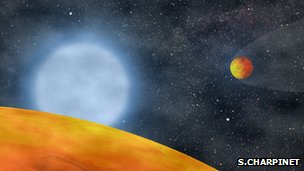
|
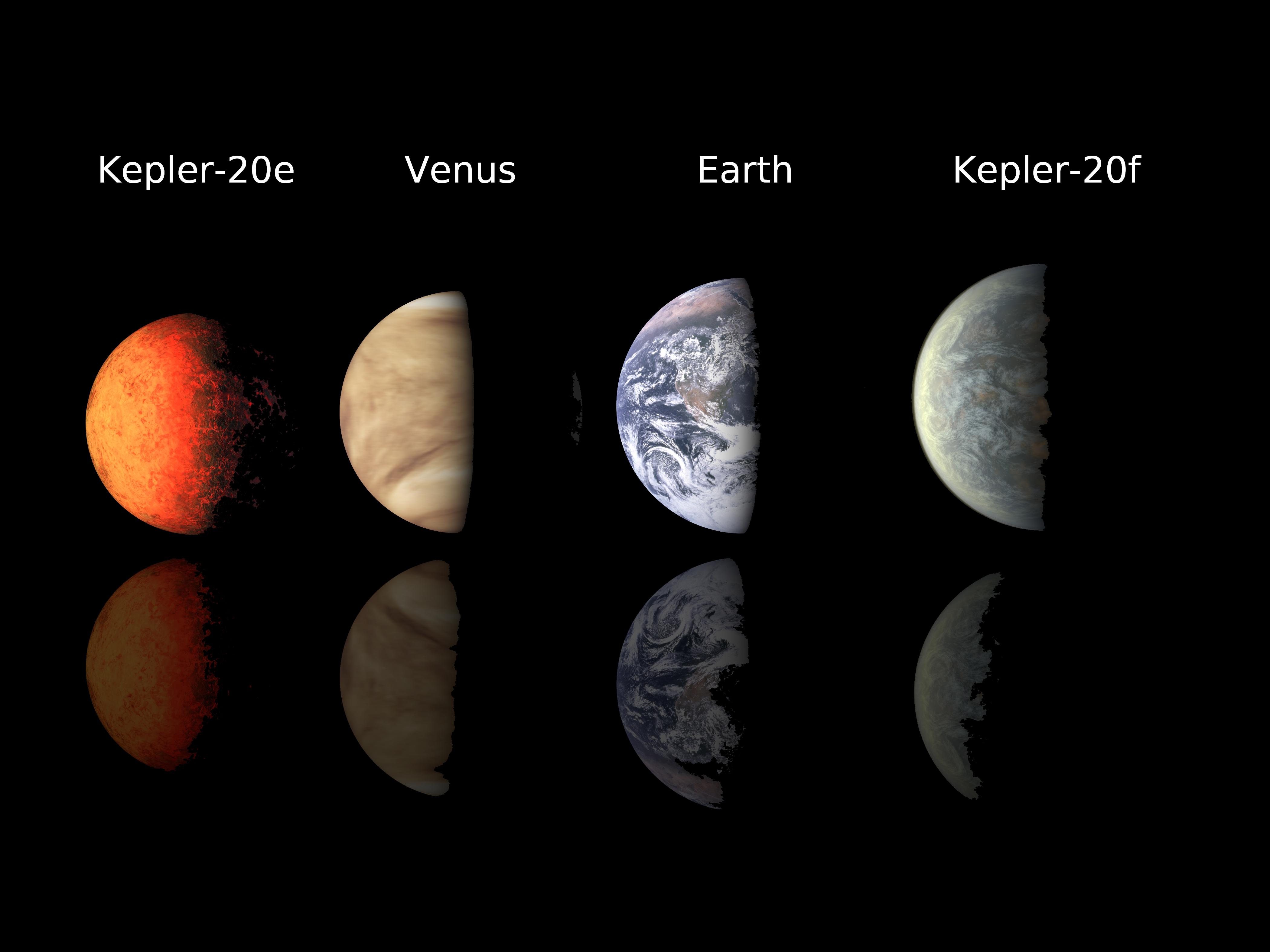
|
|
KEPLER DISCOVERS FIRST EARTH-SIZE PLANETS BEYOND OUR SOLAR SYSTEM
The Kepler mission has discovered the first Earth-size planets orbiting a sun-like star outside our solar system. The planets, called Kepler-20e and Kepler-20f, are too close to their star to be in the habitable zone where liquid water could exist on a planet's surface, but they are the smallest exoplanets ever confirmed around a star like our sun. The discovery marks the next important milestone in the ultimate search for planets like Earth. The new planets are thought to be rocky. Kepler-20e is slightly smaller than Venus, measuring 0.87 times the radius of Earth. Kepler-20f is a bit larger than Earth, measuring 1.03 times its radius. Both planets reside in a five-planet system called Kepler-20, approximately 1,000 light-years away. +read more |
|
FAST CORE ROTATION IN RED GIANT STARS DISCOVERED BY THE KEPLER ASTEROSEISMOLOGICAL SCIENCE CONSORTIUM
Spectroscopic observations reveal that the surfaces of most yellow, orange, and red giants rotate slowly-but those observations say nothing about what's happening beneath the surface. Paul Beck of the Catholic University of Leuven in Belgium and his colleagues have used data from the Kepler space observatory to study the cores of three yellow giant stars named KIC 5356201, KIC 8366239, and KIC 12008916. The stars are only 20% to 50% more massive than the sun, but they're about five times larger and 800 to 950 degrees Kelvin cooler. From more than a year's worth of Kepler data, Beck and his colleagues report online today in Nature that the cores of all three giant stars spin at least 10 times faster than their surfaces. +read more |
|
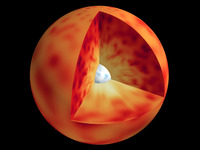
|

|
|
1.6Re PLANET CONFIRMED AROUND ONE OF THE BRIGHTEST STARS IN THE KEPLER FIELD
Kepler has revealed that one of the brightest stars in the Kepler field has a planet with a radius only 1.6 Re radius and a mass no greater that 10 earth masses, circling its parent star with a 2.8 day period. This planet, designated Kepler-21b, is only 6 million km away from its parent star. The temperature at the surface of the planet is about 1900 K, or 2960 F. While this temperature is nowhere near the habitable zone in which liquid water might be found, the planet's size is approaching that of the earth. The parent star, HD 179070, is quite similar to our sun: its mass is 1.3 solar masses, its radius is 1.9 solar radii, and its age, based on stellar models, is 2.84 billion years. +read more |
|
THE KEPLER PROJECT ANNOUNCES AN ACCELERATED DATA RELEASE SCHEDULE
In order to support the community exploitation of the Kepler data archive, the Kepler project announces an accelerated data release schedule. This schedule accelerates all data except for those included in existing agreements between Guest Observers and the Kepler Asteroseismological Science Consortium. Data from quarters 4, 5 and 6 (Dec 2009-Sep 2010) will be released on Jan 7, 2012. Quarters 7, 8, and 9 (Sep 2010-Jun 2011) will be released on Jul 28, 2012. Quarters 10, 11, 12 and 13 (Jun 2011-Jun 2012) will be released on Oct 28, 2012. All data will be available through the Data Search and Retrieval Page at MAST. Quarters collected after Q13 will have no exclusive data use period. |
||
|
PLANET IN THE HABITABLE ZONE OF A SUN-LIKE STAR AND 1,000 NEW PLANET CANDIDATES
NASA's Kepler mission has confirmed its first planet in the "habitable zone", the region where liquid water could exist on a planet's surface. Kepler also has discovered more than 1,000 new planet candidates, nearly doubling its previously known count. Ten of these candidates are near-Earth-size and orbit in the habitable zone of their host star. Candidates require follow-up observations to verify they are actual planets. The newly confirmed planet, Kepler-22b, is the smallest yet found to orbit in the middle of the habitable zone of a star similar to our sun. The planet is about 2.4 times the radius of Earth. Scientists don't yet know if Kepler-22b has a predominantly rocky, gaseous or liquid composition, but its discovery is a step closer to finding Earth-like planets. +read more |
|
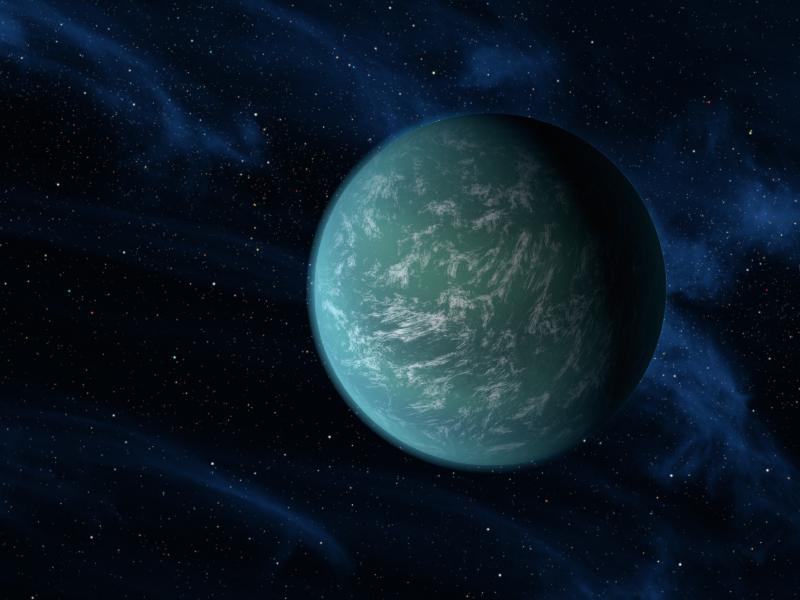
|
|
14,000 KEPLER RED GIANT TARGETS NOW AVAILABLE FOR COMMUNITY-LED ANALYSIS
The Kepler Team announce the public data release of 14,048 red giants for scientific exploitation by the community. All quarter 0 to quarter 8 light curves of these targets can now be downloaded by you and your collaborators. While there is no guarantee that a specific target in the red giant list has been observed over all past operational quarters, the maximum length of time series data now publicly available for red giant targets is 680 days. These targets remain on the Kepler target list and will continue to be observed when pixels are available. All future data collected for these targets will be delivered to the archive without proprietary periods. They do however have a low priority for the core mission exoplanet survey and are among the first targets to be dropped from the survey each quarter if pixel resources become stretched. The magnitude range of red giants in the released sample is dominated by 7.9 < Kp < 14.0. The KIC-derived stellar effective temperatures are dominated by the range 4,500 < Teff (K) < 5,100. KIC-derived surface densities mostly occur within the range 2.4 < log(g g cm-2) < 3.4. Outliers to these ranges within the public data exist. All data released within this sample can be inspected and downloaded from the Kepler Data Search Tool at MAST, by filtering the search upon a release date of 2011-09-27. We encourage the Kepler community to exploit these newly available data resources for science. The Kepler red giant sample will also be surveyed by the SDSS III APOGEE experiment providing a yield of red giants within the Galactic bulge, bar, disk, and halo. The precise radial velocities and detailed chemical abundance "fingerprinting" provide by APOGEE, combined with Kepler asteroseismology, will yield unprecedented insights into stellar physics and the dynamical structure and chemical history of the Galaxy. If the Kepler mission is extended by NASA, there will possibly be a downselect of targets from the exoplanet survey in 2013 in order to maintain a high duty cycle as our downlink bandwidth systematically decreases over time. These red giants will most-likely be among the targets dropped. It behooves the community to identify the red giants of highest value from this public sample over the next 12 months and reinstate them to the target list through the 2013 Guest Observer program (cycle 5). |
||
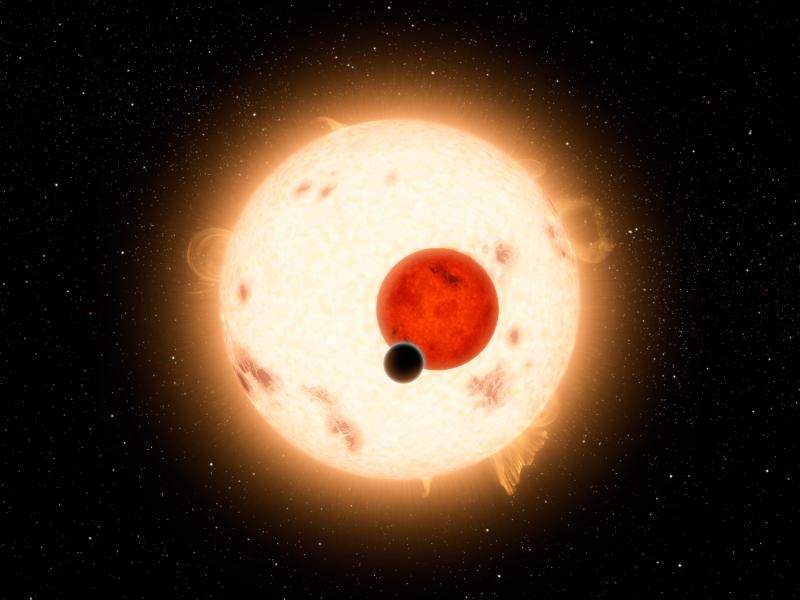
|
|
NASA'S KEPLER MISSION DISCOVERS A WORLD ORBITING TWO STARS
The existence of a world with a double sunset, as portrayed in the film Star Wars more than 30 years ago, is now scientific fact. NASA's Kepler mission has made the first unambiguous detection of a circumbinary planet - a planet orbiting two stars- 200 light-years from Earth. Unlike Star Wars' Tatooine, the planet is cold, gaseous and not thought to harbor life, but its discovery demonstrates the diversity of planets in our galaxy. Previous research has hinted at the existence of circumbinary planets, but clear confirmation proved elusive. Kepler detected such a planet, known as Kepler-16b, by observing transits, where the brightness of a parent star dims from the planet crossing in front of it. +read more |
|
SOLAR-LIKE OSCILLATIONS DISCOVERED IN A DELTA SCUTI STAR
The energy in the outer 30 per cent of the solar atmosphere is transported by convection. Below that, energy is transported by radiation. In stars twice as massive, only one per cent of the envelope is convective. Stars with higher mass should no longer possess a convective envelope, however, where exactly it disappears is unknown. Asteroseismology provides a method to explore this extreme domain. Delta Scuti stars are in the mass range where the convective envelope disappears and energy propagation is dominated by radiation. Most famously, they reveal periodic light variations due to pulsations excited by the kappa mechanism. "For over ten years, scientists have predicted that despite the small depth of the convective envelope of Delta Scuti stars, convection should have sufficient energy to excite solar-like pulsations as well. Finally we succeeded in prove this." explains Victoria Antoci of the University of Vienna writing in Nature. +read more |
|
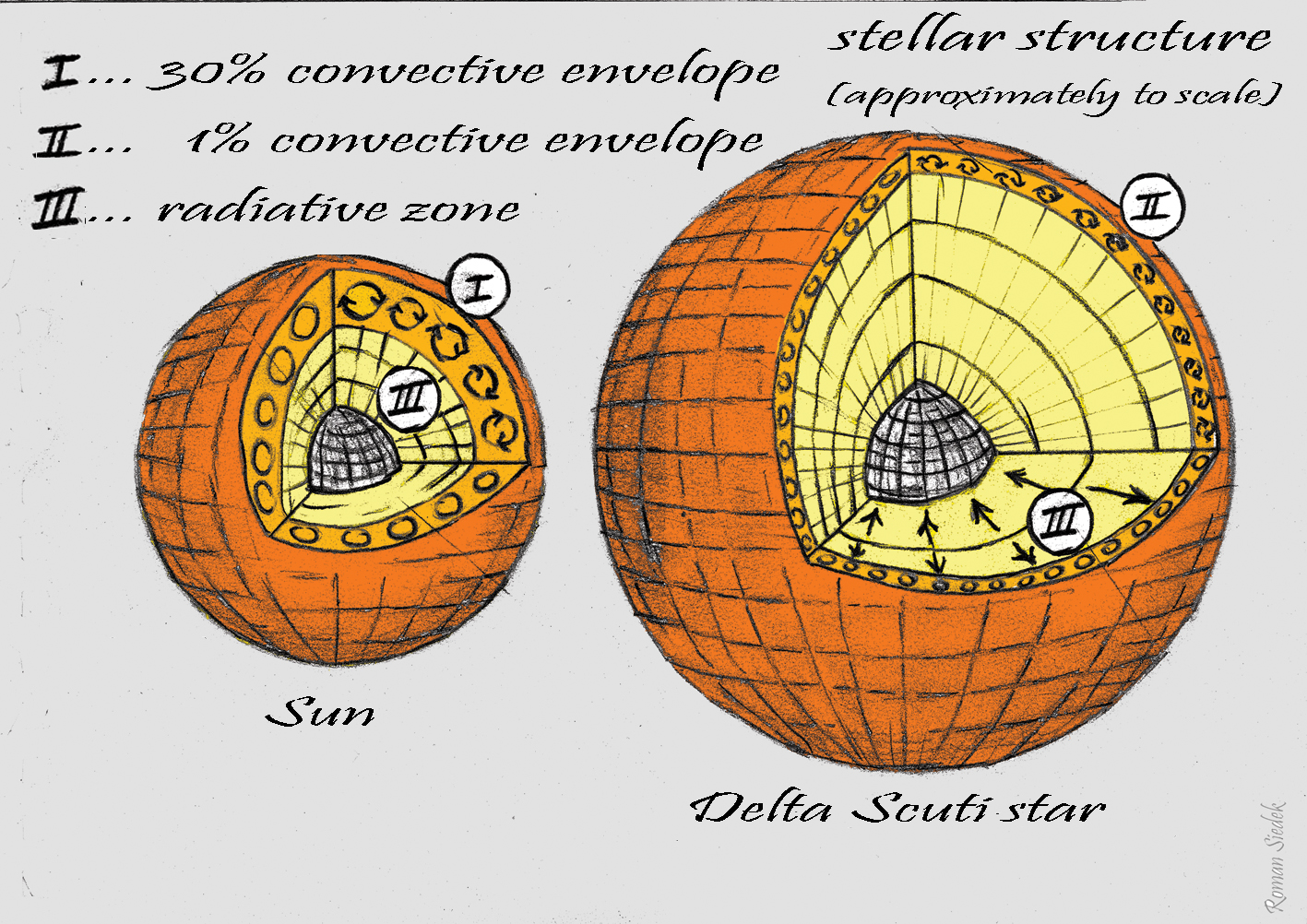
|
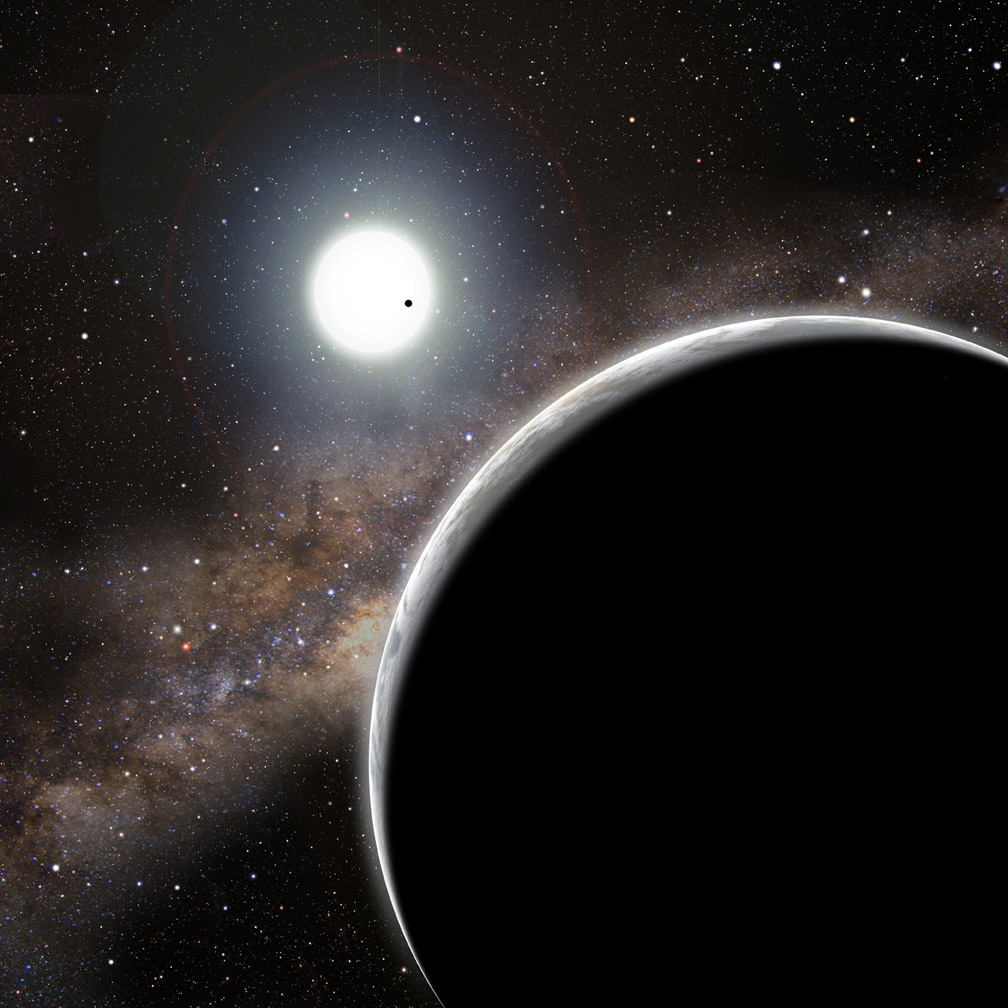
|
|
KEPLER-19C: INVISIBLE WORLD DISCOVERED
NASA's Kepler spacecraft has spotted a planet that alternately runs late and early in its orbit because a second, "invisible" world is tugging on it. This is the first definite detection of a previously unknown planet using this method. No other technique could have found the unseen companion. "This invisible planet makes itself known by its influence on the planet we can see," said astronomer Sarah Ballard of the Harvard-Smithsonian Center for Astrophysics. Ballard is lead author on the study, which has been accepted for publication in The Astrophysical Journal. Both the seen and unseen worlds orbit the Sun-like 12th-magnitude star Kepler-19, which is located 650 light-years from Earth in the constellation Lyra. +read more |
|
KEPLER MISSION ANNOUNCES NEXT DATA RELEASE TO PUBLIC ARCHIVE
The Kepler Science Team announced on Aug 12 the next release of data to the public archive. Quarter three science data collected during the period Sep 18 to Dec 16 2009 will be available for download on Sep 23, 2011 from the Multimission Archive at STScI (MAST). The majority of targets in the Kepler public archive will have a minimum of 6 months or more of near-continuous monitoring available. "The Science team recognizes a strong demand from the scientific community for more public data", said Nick Gautier, Kepler Mission project scientist. "This is evident by the volume of papers on exoplanet science as well as stellar astrophysics that have been published using Kepler data." +read more |
||
|
TRES-2B: ALIEN WORLD IS BLACKER THAN COAL
Astronomers have discovered the darkest known exoplanet - a distant, Jupiter-sized gas giant known as TrES-2b. Their Kepler measurements show that TrES-2b reflects less than one percent of the sunlight falling on it, making it blacker than coal or any planet or moon in our solar system. "TrES-2b is considerably less reflective than black acrylic paint, so it's truly an alien world," said astronomer David Kipping of the Harvard-Smithsonian Center for Astrophysics (CfA), lead author on the paper reporting the research. TrES-2b orbits its star at a distance of only three million miles. The star heats TrES-2b to a temperature of more than 1,800 deg - much too hot for ammonia clouds. Instead, its exotic atmosphere contains light-absorbing chemicals like vaporized sodium and potassium, or gaseous titanium oxide. Yet none of these chemicals fully explain the extreme blackness of TrES-2b. +read more |
|

|

|
|
'SOCCER BALL' NEBULA MAY HELP SOLVE SPACE MYSTERY
A soccer-ball-shaped planetary nebula discovered by an amateur astronomer may help scientists better understand these odd structures, which are created by the last gasps of dying stars. Researchers announced the existence of the newly discovered planetary nebula - named Kronberger 61, or Kn 61 - at a symposium today in Tenerife, Spain. Astronomers described the puffy nebula, which is located in a small patch of sky being monitored closely by NASA's planet-hunting Kepler Space Telescope, as resembling a soccer ball in deep space. Follow-up observations by Kepler may help answer key questions about planetary nebulae - such as how their formation may be shaped by companions, be they other stars or alien planets. +read more |
|
KEPLER-14B, A GIANT PLANET ORBITING ONE OF THE STARS IN A BINARY SYSTEM
Kepler-14b is a planet 8 times more massive than Jupiter, orbiting one of the stars in a binary star system. The planet has a short orbital period of just 7 days, while the two stars orbit each other with a much longer period of about 2800 years. The light from the planet hosting star is diluted by its companion star and this dilution significantly affects the derived planetary parameters, and if left uncorrected, leads to an underestimate of the radius and mass of the planet by 10% and 60%, respectively. Because of the small separation of the two stars on the sky, their binary nature was only revealed by using high resolution imaging. Such imaging has not been applied to the bulk of the over 500 exoplanets discovered and if some of these planets are in similar binary systems and the dilution effect has not been taken into account, this could significantly affect the derived planetary parameters. +read more |
|

|
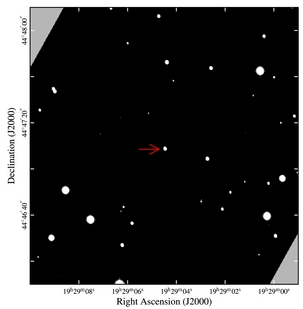
|
|
DISCOVERY OF A V777 HER PULSATOR IN THE KEPLER FIELD Roy Ostensen and collaborators have presented the discovery of the first pulsating white dwarf star located in the field of view of the Kepler spacecraft. During an ongoing effort to search for compact pulsator candidates that can benefit from the near-continuous coverage of Kepler, they recently identified a faint DB star from spectroscopy obtained with the William Herschel Telescope. After establishing its physical parameters to be Teff = 24,950 K and log g = 7.91 dex, placing it in the V777 Her instability strip, Kepler photometry revealed a pulsation spectrum consisting of five modes that follow a sequence roughly equally spaced in period with a mean spacing of 37 s. The three strongest modes show a triplet structure with a mean splitting of 3.3 μHz. They conclude that this object is a V777 Her pulsator with a mass of approximately 0.56 Msun, and very similar to the class prototype. +read more |
|
HUBBLE SPACE TELESCOPE MAKES ONE MILLIONTH SCIENCE OBSERVATION
NASA's Hubble Space Telescope crossed another milestone in its 21-year space odyssey of exploration and discovery. On Monday, July 4, the Earth-orbiting observatory logged its one millionth science observation during a search for water in an exoplanet's atmosphere 1,000 light-years away. The millionth exposure is a spectroscopic measurement of the extrasolar giant planet HAT-P-7b, also known as Kepler 2b. The planet has been studied by NASA's planet-hunting Kepler observatory after it was discovered by ground-based observations. +read more |
|
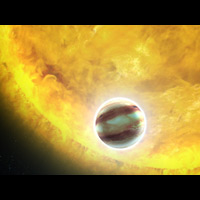
|

|
|
STELLAR ODDBALLS Kepler is a planet hunter, seeking evidence of Earth-size planets in the habitable zone of Sun-like stars. But, Kepler has found a bonus, a treasury of wonders, or one might say a stellar freak show out in space. Kepler's high-precision photometry probes the lives of stars in ways not possible before, and astronomers are being called to mine the rich data from this mission. +read more |
|
KEPLER SPACECRAFT SHOWS THAT SMALLER PLANETS ABOUND
One of the most fascinating aspects of the recent Kepler discoveries is the small sizes of the planetary candidates. For years the list of known extrasolar planets had been dominated by massive worlds comparable to or larger than Jupiter, the biggest planet in our solar system. Such massive worlds are the easiest to find, whereas more diminutive planets, of roughly Earth or Neptune size, are much more difficult to spot. But Kepler was designed to be sensitive to those smaller worlds, even the temperate, rocky worlds that might be habitable-and it has not disappointed. The spacecraft is showing that smaller planets are common - more common, in fact, than their larger brethren. At least that is how things look in the inner regions of planetary systems, where Kepler's data is currently the strongest. +read more |
|
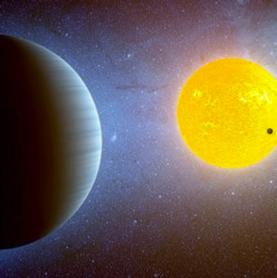
|
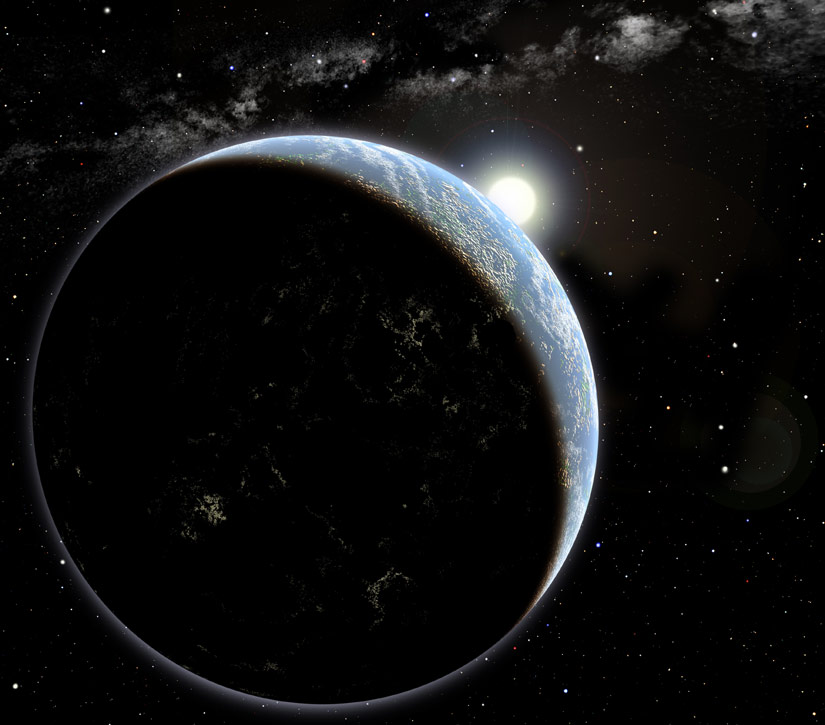
|
|
HOW TO LEARN A STAR'S AGE "A star and its planets form together and share the same age, so if we can determine the age of a star, we also have the ages of its planets," Soren Meibom from the Center of Astrophysics told reporters at the American Astronomical Society meeting in Boston on May 23. "The question of age is highly relevant to the question of life." Soren heads a team that determines stars' spin rates, which vary depending on how old a star is. The Kepler telescope, which is conducting a survey of extrasolar planets, is proving very adept at finding stars' spin rates, even among the galaxy's older stellar residents. +read more |
|
FIRST KEPLER SCIENCE CONFERENCE SCHEDULED
The First Kepler Science Conference will be held 5-9 December 2011, hosted by the NASA Ames Research Center in Mountain View, California. The conference will highlight the full range of scientific results that have emerged from more than two years of Kepler data, as well as what to expect from continued observations. The meeting will consist of 9-10 half-day sessions, each session dedicated to a different topic. Likely session topics: | ||
Further details can be found at the conference website. If you are interested in attending, we would greatly appreciate completion of a short survey. |
|
|
|
KASC SCIENTISTS DETECT ECHOES FROM THE DEPTH OF A RED GIANT STAR KASC astronomers report the discovery of waves inside a star that travel so deep that they reach the core. The discovery was possible thanks to precise measurements with the Kepler space telescope. Up to now only waves in the outer part of the star were observed. The team now unexpectedly found the signature of waves that run all the way to the center of the star. These gravity mode diagnostics have been found over a large sample of red giants, revealing both helium burning stellar cores and hydrogen burning shells along a range of the post-main sequence evolutionary track. |
||
|
KEPLER SPECIAL SESSION AT BOSTON AAS MEETING We call attention to the the special Kepler session to be held at the upcoming American Astronomical Society meeting in Boston on 22-26 May 2011. Organized as a 'meeting within a meeting', the AAS has scheduled the Kepler-themed sessions on 23-25 May. The morning and afternoon sessions on 25 May, are entitled 'Astrophysics with Kepler', and focus on non-exoplanet science enabled by the Kepler mission. These sessions should be especially valuable for GO and community-based researchers. Poster sessions will accompany each of the scheduled oral sessions. The Kepler talks are being organized by Eric Ford from the University of Florida, who can be contacted for more information. |
|

|
|
CUSTOM LIGHT CURVE SOFTWARE TOOL AVAILABLE A Python-based software tool for constructing custom light curves from target pixel images is now available to the community. This tool is called "kepextract" and is an addition to the PyKEP set of routines for Kepler data analysis. kepextract can be found on this web page under the "Tools / Contributed Software / PyKEP" tab. Instructions for downloading and installing this software are included on the PyKEP page. |
||
|
KEPLER INPUT CATALOG PAPER SUBMITTED A paper describing the Kepler Input Catalog is now available on the arXiv e-print Abstract Service. The authors are responsible for the development of the KIC; this paper will greatly aid Kepler observers and data users in understanding the origin and reliability of KIC parameters. |
||
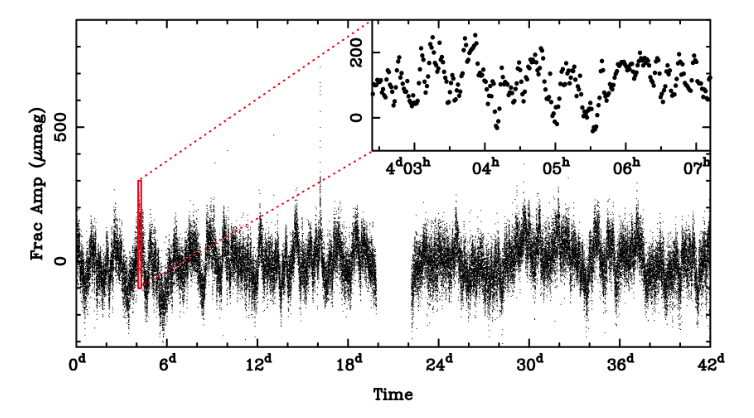
|
|
LIGHT CURVE FOR θ CYG RELEASED The Guest Observer Office has released the Q6 light curve for the bright star θ Cyg for community analysis. Classified as an F4 dwarf with V = 4.48, θ Cyg is the brightest star on active silicon located within the Kepler field. This short cadence data was obtained by the GO Office during Q6 to develop procedures for observing saturated sources requiring dedicated pixel masks and to understand Kepler's capabilities for photometry of bright, saturated sources. More information and a link to the data file can be found on the Public Data page for this object. |
|
PIXEL LEVEL DATA AVAILABILITY Target pixel files for Q0-6 will become available through the MAST starting in late January 2011. The order of ingest is expected to be: Q1, Q2, Q0, Q6, Q3, Q4, Q5. These files provide the time series of raw and calibrated pixels, allowing users to inspect their targets at the pixel level and perform their own aperture photometry. Custom targets and dedicated mask data will be available for the first time as TPFs, but these datasets will not have associated light curves. The Archive Manual will be updated to describe the formats for the target pixel files. A software tool which allows the user to construct aperture photometry light curves from the target pixel data can be found here. |
||
|
AAS SEATTLE SPLINTER SESSION: GETTING STARTED WITH KEPLER This session will introduce the Kepler Mission, describe the pipeline processing, and summarize the data products available in the Kepler archive at the Multi-mission Archive at STScI (MAST). Data products include high-precision photometric light curves and target-pixel files at 30-min and 1-min cadences, as well as monthly full-frame images. The data products are available in raw, calibrated, and detrended versions. The new target pixel files will be described in some detail, as these will be released for the first time by February 1, 2011 and will enable custom photometry by end users. The suitability of the various product versions for particular astrophysical and exoplanet investigations will be addressed; the precision and power of Kepler's photometry and centroid data will be demonstrated. The material presented at this session can be downloaded here. This an opportune time to get involved with Kepler, as the bulk of the data from the first 43 days of science is publicly available at MAST and the sequestration period for the most interesting 400 targets ends on February 1, 2011. Moreover, an additional 90 days of data will be released on February 1, and longer data segments have already been released for individual targets as they are published. The time line for future data releases will be presented, as well as opportunities for funding, selecting targets to be observed, and other involvement in the Kepler Mission. The session will end with a question and answer period, followed by one-on-one discussions and tutorials as time permits. |
||
|
TARGET CROWDING AND CONTAMINATION AT MAST It has come to our attention that the target-specific contamination (and
crowding) values currently returned by the Kepler
Target Search form at the
MAST have been used for analysis of archived Kepler
flux light curves. The contamination and crowding values at the MAST are NOT suited for such an
analysis and will most likely lead to INCORRECT conclusions. |
||
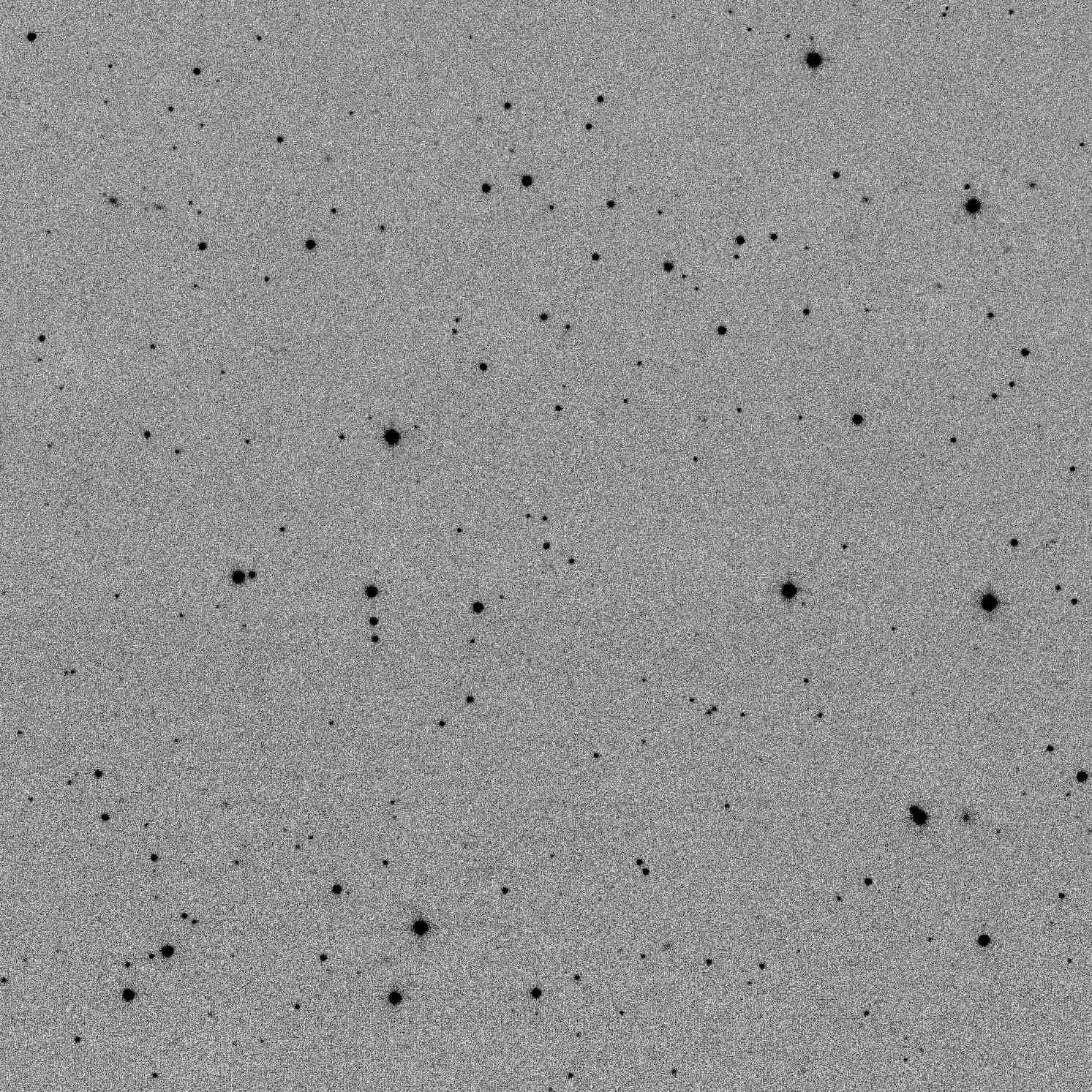
|
|
J-BAND UKIRT DATA OF THE KEPLER FIELD AVAILABLE TO THE COMMUNITY Images and source tables for the Kepler field observed through the IR J-band are available to the community through the archive and data tools housed at the WFCAM Science Archive in Edinburgh. The images have a typical spatial resolution of 0.8-0.9 arcsec and the image depth is J = 19.6 (Vega), enhancing greatly the existing 2MASS data within the Kepler Input Catalog. The data are especially useful for separating blended stellar pairs and spatially resolving external galaxies. This dataset is intended to (i) assist with detection of false-positive exoplanet transit signals, (ii) assist with the selection and characterization of Guest Observer targets and (iii) potentially identify infrared variable sources within the Kepler field, by comparison with 2MASS data. +read more |
|
KEPLER CYCLE 3 GUEST OBSERVER PROPOSAL DEADLINE ON DEC 17, 2010 The deadline for Cycle 3 Guest Observer proposals approaches rapidly. Proposals need be submitted to NASA, via the NSPIRES website before Friday, December 17, 2010. NASA solicits proposals from the astronomy community for the acquisition and analysis of new scientific data using Kepler's high-precision photometric capability during the period June 2011 through June 2012. Approximately US $1.2 million is expected to be available to fund successful US applicants in Cycle 3, but applications from all nationalities will be treated equally. Proposals submitted to this program should be for new observations and should address areas of astrophysics outside of the exoplanet Key Project. GO programs may propose observations of any source located within the ~100 square degree field-of-view, and which fall on one of Kepler's 80 CCD channels. Kepler's unique capability of continuous monitoring at 1 or 30 minute cadences over timescales of 1-12 months permits a wide range of astrophysical investigations. +read more |
||
|
KEPLER PARTICIPATING SCIENTIST AO-2 PROPOSAL DEADLINE ON FEB 11, 2011 NASA solicits proposals for the Kepler Participating Scientists Program (PSP). The Kepler PSP is designed to augment the skill set of the Kepler Science Team, thereby enabling it to more effectively execute the science program of the mission. Participating Scientists serve as members of the Kepler Science Team and participate in Science Team activities such as data processing and analysis, transit candidate follow-up and characterization, and publication. The Kepler PSP is complementary to, but distinct from, the Kepler Guest Observer (GO) program. The Kepler GO program offers the opportunity for members of the scientific community to select targets of general astrophysical interest in the Kepler field-of-view (both stellar and non-stellar), in pursuit of investigations that fall outside of the scope of the Kepler Science Team. Notices of Intent to propose to the PSP are due Jan 7, 2011. Proposals are due February 11, 2011. +read more |
||
|
QUARTER 2 KEPLER DATA TO BE RELEASED TO THE PUBLIC ON FEB 1, 2011 Quarter 2 is the first Kepler data sequence consisting of a complete 3 months of observations from Jun-Sep 2009. It contains light curves for approximately 165,000 stars (most of which are late-type main sequence stars) brighter than 16th magnitude sampled at a 30-minute cadence. Three subsets of one-month each of [up to 512] stars were sampled at 1 min cadence. The shorter cadence data will be released on the same schedule. Only some Q2 GO targets will be kept back from this release until April 2011, in accordance with the 2009 Kepler NASA Research Announcement. The motivation for the early data release is to better support the 2011 NASA Astrophysics Data Analysis Program (ADAP), a funding opportunity which supports the analysis and interpretation of data in the public archives. By tripling the volume of Kepler data in the public archive, the project hope to open research opportunities that can be grant-funded under the ADAP umbrella. The project will hold a splinter session at the AAS meeting in Seattle to inform potential users of how to make use of the archive. +read more |
||

|
|
KEPLER TAKES THE PULSE OF DISTANT STARS The Kepler Asteroseismology Consortium (KASC) have announced the detection of stellar oscillations that yield new insights about the size, age and evolution of stars. Results were presented at a news conference at Aarhus University in Denmark. The team studied thousands of stars observed by Kepler, releasing what amounts to a roster of some of humanity's most well-characterized stars. Analysis of stellar oscillations is similar to how seismologists study earthquakes to probe the Earth's interior. This branch of science, called asteroseismology, produces measurements of stars the Kepler science team is anxious to have. +read more |
|
PUBLIC RELEASE OF Q0-1 DATA The Kepler mission announces the first main delivery of public data from quarters 0 and 1 of operations (May 2 - Jun 18, 2009). Calibrated cadence data for individual sources can be obtained from the Multi-mission Archive at the Space Telescope Science Institute (MAST) via the Kepler Data Search and Retrieval form. The software pipeline at the Kepler Science Operations Center (SOC) and the instrument calibration are on-going projects, investigators are urged to read the Data Release Notes #5 in order to understand the accuracy and limits of this, and future, data releases. +read more |
|
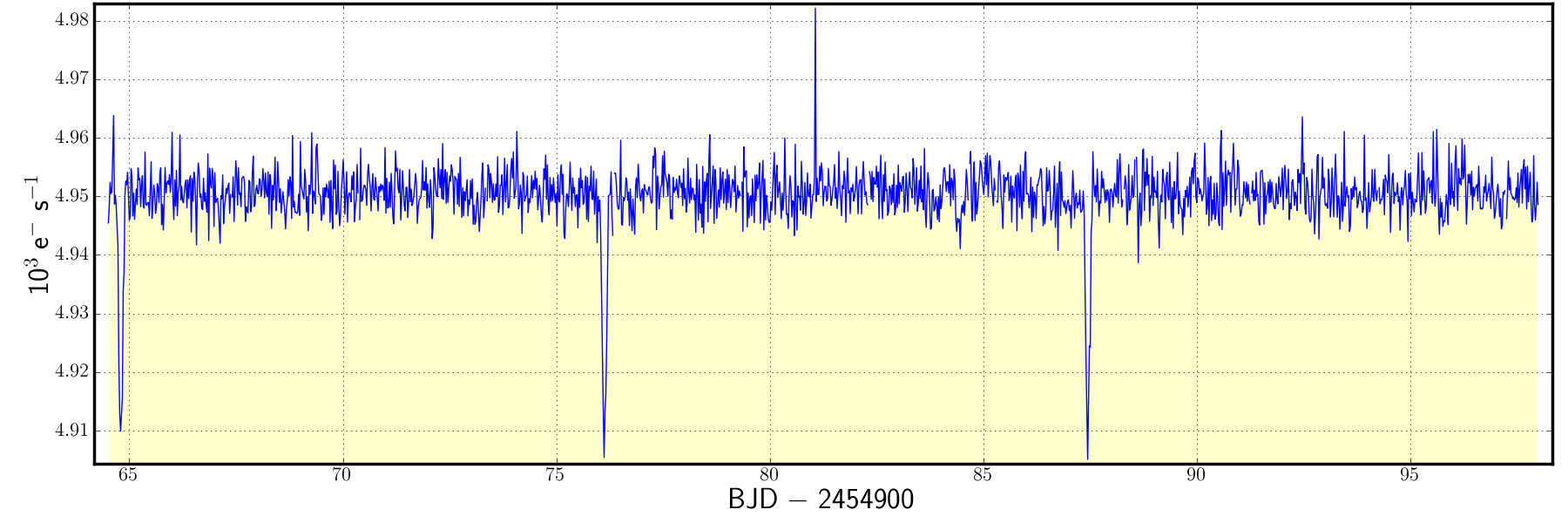
|

|
|
Q3 GUEST OBSERVER DATA AVAILABLE THROUGH THE MAST The Kepler mission announces the second release of Guest Observer time series data and Q3 dropped targets. Calibrated photometric data for individual sources can be obtained from the Multi-mission Archive at the Space Telescope Science Institute (MAST) via the Kepler Data Search and Retrieval form. All GO data has a proprietary period and will become public on an approximately yearly schedule. The software pipeline at the Kepler Science Operations Center (SOC) and the instrument calibration are on-going projects, investigators are urged to read the Data Release Notes #4 (pending) in order to understand the accuracy and limits of this, and future, data releases. +read more |
|
KEPLER AO-2 GO SCIENCE PROGRAM ANNOUNCED An independent Target Allocation Committee met Mar 10-12, 2010 to consider the Guest Observer proposals submitted for Cycle 2, covering observations for 1 year from Jun 2010. 3,000 long cadence targets per quarter and 25 short cadence targets per month were available for non-exoplanet science exploitation. 22 proposals were selected for GO grant funding, 13 were selected as unfunded non-US led programs or valued program filler once the grant budget was exceeded. The funded program was oversubscribed in targets by a factor 8.1. The abstracts for all successful programs are available. +read more |
||
|
|
||
|
GO DIRECTOR'S DISCRETIONARY TARGET (DDT) COMPETITION OPEN The DDT Program is a quarterly competition, i.e. it occurs on a 3 month cycle. Observations can be proposed for at any time and targets will be uploaded during the next spacecraft roll. The first quarter available for the DDT program is quarter 6 (Jun-Sep 2010). Up to 100 DDTs are available each quarter. No Guest Observer funding will be provided for DDTs. Proposals from all institutions and countries are encouraged. The proposal process is informal, requiring an email request from the proposer to the GO Office. There is no peer review of DDTs; program target selection is at the discretion of the GO Office Director. The purpose of the DDT program is to Provide a fast-track to Kepler data, yield rapid, high-impact science from Kepler, and quickly build a significant sample of Kepler GO papers. +read more |
||
|
KEPLER AO-2 CALL FOR PROPOSALS NOW CLOSED The Kepler cycle 2 Guest Observer Program reserves 3,000 targets for the general astronomy community to pursue research programs across a broad range of astrophysics. The most recent call for scientific proposals closed on Jan 22, 2010. These targets are competed for on an annual cycle and awarded by a peer review panel comprised of independent scientific experts. The cycle 2 program received 54 unique science proposals and is oversubscribed by a factor 2.3 in budget and a factor 2.4 in targets. Proposed programs involve investigators from 77 academic and science institutions, and from 18 different countries. The panel will meet and recommend targets and research awards to NASA on Mar 10-12. |
||
|
|
||
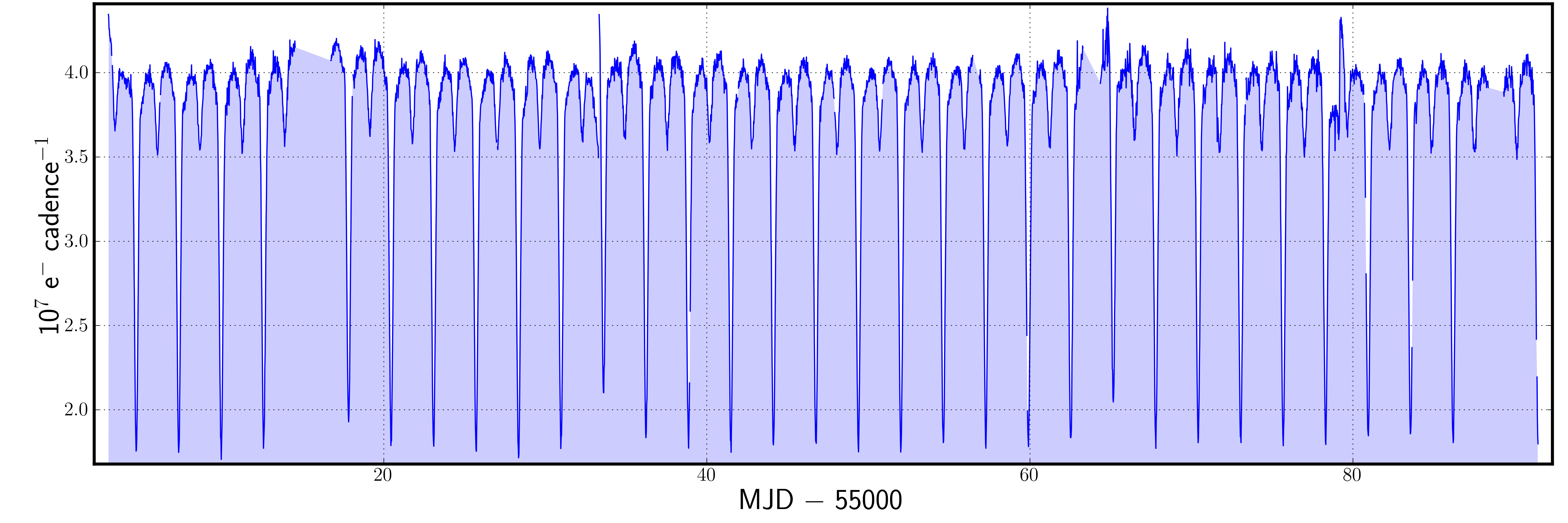
|
|
Q2 GUEST OBSERVER DATA AVAILABLE THROUGH THE MAST The Kepler mission announces the first release of Guest Observer time series data and Q2 dropped targets. Calibrated cadence data for individual sources can be obtained from the Multi-mission Archive at the Space Telescope Science Institute (MAST) via the Kepler Data Search and Retrieval form. All GO data has a proprietary period and will become public on an approximately yearly schedule. The software pipeline at the Kepler Science Operations Center (SOC) and the instrument calibration are on-going projects, investigators are urged to read the Data Release Notes #3 in order to understand the accuracy and limits of this, and future, data releases. +read more |
|
ALL SELECTION RESTRICTIONS ON KEPLER GO TARGETS ARE DROPPED In response to the quality of Kepler data, requests from the scientific community, and with the purpose of opening the Kepler mission to more astrophysics, the Kepler Team announce that from GO cycle 2 and beyond, all restrictions on GO target selection have been removed. New policy is reflected with a new amendment to the cycle 2 NASA Research Announcement. All targets within the Kepler field of view are now open to Guest Observer proposals, with a few minor caveats to prevent redundancy with existing projects. In order to protect the key exoplanet program, GOs must agree to non-disclosure of exoplanet science and we urge you to read and understand this policy, as described in the NRA. Exoplanet science remains outside of the scope of the GO program and is the exclusive activity of the Kepler Science Team. +read more |
||
|
|
||
|
KEPLER INSTRUMENT HANDBOOK PUBLISHED The Kepler Instrument Handbook (KIH) has passed through the ITAR process and is now available for public download. The KIH contains descriptions of Kepler hardware, calibrations and the artifact mitigation process. +read more |
||
|
KEPLER COMMISSIONING DATA RELEASED TO PUBLIC The Kepler mission announces the first public release of Kepler time series data. Data for individual sources can be obtained from the Multi-Mission Archive at the Space Telescope Science Institute (MAST). During a 10 day commissioning phase (termed Quarter 0) in May 2009, the Kepler spacecraft observed 52,463 sources in order to exercise the capabilities of the science instrument. During this phase, the Project Team observed mainly bright stars in the field of view to define operational parameters for the following Science Mission. After review of these data, 8,441 sources were dropped from further observation after Quarter 1 and the Quarter 0 dropped data are now available for public download. +read more |
|

|
|
TARGET SEARCH FORM AND KEPLER INPUT CATALOG RELEASED
BY MAST The MAST Kepler web site is now public. Users may now query the 6 million row Kepler Target Search Form for selecting potential targets known to be on the CCD detector, or the Kepler Input Catalog for searching through 13 million objects in or near the Kepler field of view. +read more |
||
|
|
||
|
KEPLER SPIES CHANGING PHASES IN A DISTANT WORLD The Kepler space telescope has detected the atmosphere of a known giant gas planet, demonstrating the telescopes extraordinary scientific capabilities. These new data indicate the mission is indeed capable of finding Earth-like planets, if they exist. +read more |
|

|
|
|
||

|
|
KASC TARGET LISTS FOR FIRST 140 DAYS OF THE MISSION RELEASED The Kepler Asteroseismology Science Consortium targets have been defined. The target lists contain 293 short cadence KASC targets during commissioning, 509 short cadence KASC targets and 1350 long cadence KASC targets during first roll and 1345 short cadence KASC targets and 1351 long cadence KASC during second roll. KASC will also get access to 1000 long cadence astrometric targets observed during the entire mission. +read more |
|
FIRST SCHEDULED DATA DOWNLOAD Kepler is more than 10,700,000 km from Earth and continues its planned drift-away orbit. Today, data collected continuously since science operations began on May 12, 2009 were downloaded to the Kepler Science Operations Center at Ames Research Center, Moffett Field, Calif. The data were collected from observing over 145,000 stars simultaneously. Scientists will begin in earnest the analysis of this data to search for other Earth-size planets. Engineers also completed Kepler's planned quarterly roll. This roll will ensure that Kepler's solar arrays are kept optimally positioned with respect to our sun for the next three months. Both the science data download, and the quarterly roll, are Kepler "firsts" in its planned three-and-a-half-year mission. +read more |
||
|
|
||
|
KEPLER FOCUS IS OPTIMAL The Kepler telescopes focus has been successfully optimized. This involved moving the primary mirror of the telescope toward the focal plane array, the area where light is focused, by 40 microns (1.6 thousandths of an inch) and tilting it by 0.0072 degrees. Various other calibrations are underway. +read more |
||
|
|
||
|
KEPLER IS COLLECTING TIME SERIES DATA Following a successful readiness review, Kepler began its search for planets around other stars at 5:01 p.m. Pacific Time (8:01 p.m. Eastern Time) on May 12, 2009. The first of the science data are scheduled to be sent down to Earth on June 18, at which point analysis of the data by the science team will commence. While it will take years to discover any Earth-size planets orbiting in the habitable zones of stars, in the months ahead, we expect to begin detecting large planets that orbit their stars closely. +read more |
|

|
|
|
||

|
|
NASA'S KEPLER CAPTURES FIRST VIEWS OF PLANET-HUNTING TERRITORY NASA's Kepler mission has taken its first images of the star-rich sky where it will soon begin hunting for planets like Earth. The first light images show the mission's target patch of sky, a vast starry field in the Cygnus-Lyra region of our Milky Way galaxy. One image shows millions of stars in Kepler's full field of view, while two others zoom in on portions of the larger region. +read more |
Questions concerning Kepler's science opportunities and open programs, public archive or community tools? Contact us via the email address.